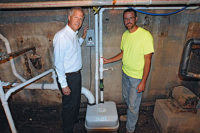Minnesotans have a well-earned reputation for toughing out the snow and cold each winter, but even this hardy state was tested over the recent harsh winters.
With at or near record lows, heating systems across Minnesota were put to the test. And while many commercial buildings required more energy to keep occupants comfortable with consistently below-freezing temperatures, one private school in the south-central region actually saved money last season.
St. John’s University, an all-male, Benedictine school in Collegeville, Minn., undertook a heating system retrofit just in time. Campus HVAC Service Technician David Schlumpberger oversaw the project and notes a local Ferguson branch suggested the school consider replacing the pumps in the Peter Engel Science Center with Grundfos MAGNA3 smart circulator pumps.
“I wasn’t aware of them before, but the existing pumps were nearing the end of their lives, so we decided why don’t we do something more efficient?” Schlumpberger says.
A logical solution
Energy efficiency is important on every campus, but environmental stewardship is a core Benedictine tradition at St. John’s, which boasts an Office of Sustainability and sits on 2,700 acres that range from wetlands to lakes and prairies to forests.
Schlumpberger says he and his team opted for the circulators due in large part to the products’ sophisticated electronic technology and demonstrated energy efficiency. Grundfos notes although the MAGNA3 has a higher up-front cost, its performance produces fast payback on the investment, post-installation. The energy-optimized, variable-speed wet rotor circulator with a permanent magnet motor design will cut power consumption up to 85%, the company adds.
Brian Soderholm, vice president of engineered product sales at Ramsey, Minn.-based manufacturers representative Soderholm and Associates also worked on the project. Soderholm and Associates, AIM/R and ASA members, has been providing full service market-managing representation for manufacturers for more than 50 years. The company puts a major emphasis on providing water- and energy-efficient solutions for its customers in Minnesota, Wisconsin, North Dakota, South Dakota, the Upper Peninsula of Michigan and Iowa.
“These pumps adapt to existing situations and can be adjusted accordingly,” Soderholm says. “This was a huge improvement over the Science Center’s antiquated pumps.”
Replacing the four older pumps with the MAGNA3s updated the system, increased efficiency and improved building comfort. A key function in the upgrade is the MAGNA3’s AutoAdapt function, which saves energy and money by continuously fine-tuning power consumption, discharge head and flow rates to meet the dynamic needs of the system.
The installation
Laid out in four wings, the Peter Engel Science Center is primarily used during the school year, running heat from fall through spring. It was built in the 1960s of concrete, typical of that era and of the construction style found throughout the rural campus.
“We had a feeling the old pumps were oversized, but there was no way to tell — until we did the replacement,” Schlumpberger says.
The building contains two primary circulators, pumping hot water supplied by a steam-to-hot-water convertor with the steam coming from a central plant. There are four pumps on the secondary loops – each serving a different wing – feeding baseboard heating that uses pneumatic three-way mixing valves to help regulate the temperatures.
Initially, Schlumpberger and his team thought the outdated pumps were on a variable-flow system. “But after the pumps were installed and we started it up, we realized the system was not variable; it was a fixed flow,” he says.
Since the building wasn’t zoned and no VFDs (variable frequency drives) were installed, the entire system was operating full-bore throughout the heating season. The team performed an audit of the existing pumps and found the north wing was originally designed for 41.5 gpm at 20 ft. of head; the south — 24.1 gpm at 21 ft.; the east — 23.7 gpm at 21 ft.; and the west — 17.4 gpm at 21 ft.
“As suspected, the engineers had oversized that older system,” Soderholm says. “Oversizing wastes energy and is hard on the pipes. In fact, we saw evidence of that in some copper piping that Dave’s staff removed. The insides of the piping were lined with ridges, indicating damage from excess velocity.”
Soderholm notes the intelligent technology of the four new circulators minimizes energy costs. The pump has a built-in energy meter and a flow-limiting function. Even at reduced loads, these circulators save energy compared with conventional circulators. They’re also an all-in-one option for building owners, eliminating the need for costly installation of a companion flow meter, pressure and temperature gauges, throttling valve, constant-speed pump or BTU meter.
“With the new circulators we were able to get the necessary flow rates at much fewer feet of head [lower pressure],” Soderholm says. “Over time, I think they’ll be able to slash their energy use even further. Even though this was not a system with variable-flow characteristics, the payback numbers are still really impressive.”
Encouraging results
When looking at the premium of going with the four MAGNA3 units, the payback for the Science Center will be under three years for three of the new circulators and just slightly longer for the fourth.
“We sized the pumps to match the old pumps, not knowing what their true system requirements were,” Soderholm says, explaining they had only the rating plates to go by since their analysis was conducted during summer.
“Even though the Grundfos pumps are larger than necessary for this building,” he continues, “it’s not wasteful because we were able to dial them down with impressive results.”
The north wing was reduced to 39.6 gpm at 14.8 ft.; the south — 25.5 gpm at 9.2 ft.; the east — 21.1 gpm at 8.53 ft.; and the west — 12.8 gpm at 7.2 ft.
What that translates into is an estimated yearly savings of $693. “The bottom line is the MAGNA3 is sophisticated and capable of doing everything the old pumps did, only better because it’s smart,” Schlumpberger says. “It can tell itself to slow down or speed up based on current demand. Another benefit is that now we can get data off the pumps’ readout and learn more about the building’s needs.”
Schlumpberger adds despite enduring the coldest winter in 30 years during the 2014 season, pumps at the facility were running at 25% of the head the old models had while still keeping the building warm.
“In other words we’re actually able to run the system at the original designed flow rate using less power, less energy and at less cost,” he says.
With measurable retrofit results this significant and evidence of other older heating systems on campus needing replacement, Schlumpberger is considering additional MAGNA3 installations.
“The Science Center project is a good barometer of the payback potential,” he says. “We will decide on a case-by-case basis, but it’s a very likely a possibility down the line.”
Author bio: Kurt Vigil is a business development manager for Grundfos Pumps Corp. He may be reached at kvigil@grundfos.com.
This article was originally titled “Best bang for the buck” in the September 2015 print edition of Supply House Times.








